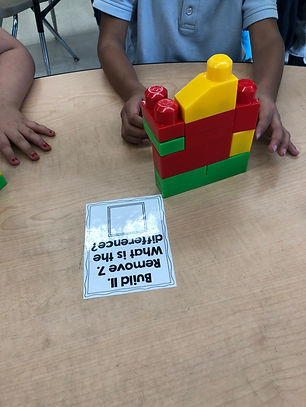Manipulatives
Math Manipulatives
I use math manipulatives as a resource during math to ensure students are introduced to a task through different representations, and are able to show their understanding through multiple models. Counting out how many blocks they need when completing an equation helps students connect the numer they see in a problem and the quantity that they build using their blocks. This helps students develop their number sense, a crucial foundational skill (Griffin, 2004). When students are given the opportunity to use materials that are interesting and exciting, such as colorful blocks, they are more likely to be interested in and excited about the learning task. When students feel this excitement and are more deeply engaged in the activity, they will likely find greater academic success through their willingness to participate in an active way (McRae & Guthrie, n.d.).
The video here shows a student using manipulatives to solve a missing addend problem on a part-part-whole mat. The student uses the phrase "whole minus part equals part" to help her remember to start by building the whole number, then take away the part that is known. The student was able to find the correct answer and fill in the missing part. I was able to ask probing questions to help her use the manipulatives in a way that led to success in learning. This student was struggling with the task but was able to use manipulatives to support her work.


The pictures here shows students developing a stronger understanding of basic shapes by using manipulatives to build shapes. The first picture shows a student using a diamond in an attempt to build a hexagon. This directly supports students' mastery of Common Core standard 1.G.A.2, "Compose two-dimensional shapes (rectangles, squares, trapezoids, triangles, half-circles, and quarter-circles) or three-dimensional shapes (cubes, right rectangular prisms, right circular cones, and right circular cylinders) to create a composite shape, and compose new shapes from the composite shape." The second picture shows students building extravagant shapes during the MakerSpace center. MakerSpace activities help students develop creative thinking and problem solving skills.
The blocks shown here allow students to build different shapes and designs with the appropriate number of blocks needed to solve a word problem. This allows students to use their imagination as well as their mathematical thinking. Students are always excited to use the building blocks to build and break apart structures. They are excited that the manipulatives they use allowed for a creative building process that uses their imagination. This fosters self-expression in the classroom and helps get students excited about learning.



I store all math manipulatives on an easily accessible shelf. This allows students to self-select when they need to use manipulatives during independent tasks in the classroom. Students will often bring blocks to their desk when completing challenging math tasks at the independent work center during small group instruction. I am also able to give manipulatives to individual students to support their learning and respond to their diverse learning needs.